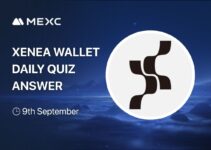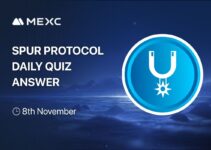The crypto industry is watching, with immense anticipation, the launch of what may be the most significant Layer-1 (L1) blockchain of 2025: Monad ($MON). Monad is not just “another Ethereum killer.” It is a foundational re-architecture of the Ethereum Virtual Machine (EVM) itself, designed to solve the single greatest bottleneck in crypto: sequential execution.
Monad introduces “parallel execution” to the EVM, aiming for a theoretical throughput of 10,000 transactions per second (TPS) while maintaining 100% compatibility with existing Ethereum applications. As the project’s public mainnet launch approaches on November 24, 2025, and its first-ever public token sale is live on Coinbase now (November 17-22), this article provides a professional, trader-focused analysis of the technology, the hype, and the market-changing implications of this “Parallel EVM.”
1. The “Problem” Every Trader Knows
To understand why Monad is attracting such attention, you only need to remember one thing: your last “gas spike.”
Every crypto user has felt the pain of Ethereum’s core limitation. When a hot NFT mints or a market panic causes a cascade of liquidations, the network grinds to a halt. Gas fees skyrocket, and your transactions either fail or are stuck pending for minutes.
This happens because the EVM is a “single-lane road.” It processes transactions one by one, in a strict, sequential order. If one complex transaction is slow, it creates a traffic jam for everyone behind it. This sequential bottleneck is the primary reason Ethereum itself can only handle 15-30 TPS.
For years, this has given developers two bad options:
– Build on an L2: Use a Layer-2 rollup, which is faster but still forces users to pay Ethereum’s high settlement fees and deal with the complexities of bridging.
– Move to a Non-EVM L1: Build on a high-speed L1 like Solana. This offers incredible speed but requires developers to learn a new programming language (Rust) and rebuild their entire application from scratch, cutting them off from Ethereum’s massive ocean of developers, liquidity, and established dApps.
Monad proposes a third, “holy grail” solution.
2. The Solution – The “Parallel EVM” Superhighway
Monad’s “killer feature” is that it brings parallel execution to a fully EVM-compatible environment.
In simple terms: Monad is a 10-lane superhighway built for Ethereum’s cars.
It doesn’t create a new highway system in a different country; it rebuilds Ethereum’s existing “single-lane road” to handle a massive increase in traffic. All of Ethereum’s existing “cars” (dApps) and “drivers” (developers) can use it immediately, with no changes.
This isn’t a simple tweak. The Monad team, which includes high-frequency trading (HFT) experts from Jump Trading, has completely re-engineered the EVM’s “engine” from the ground up to achieve this.
While traditional chains process transactions one by one, Monad’s architecture does two things:
1. Optimistic Execution: It processes thousands of transactions at the same time in parallel, on the assumption they don’t conflict.
2. Conflict Detection: It intelligently monitors these parallel transactions. If it finds two that do conflict (e.g., they both try to spend the same money from the same wallet), it simply re-processes those two transactions sequentially, while the other 9,998 continue in parallel.
This combination allows Monad to achieve theoretical speeds of 10,000 TPS and 1-second block times; all while “speaking” the same language as Ethereum.
3. What This Actually Means for the Crypto Ecosystem
This is not just a technical curiosity; it has profound implications for traders and users.
1. The End of the “Ghost Town” L1
The biggest problem for new L1s is attracting developers and users. Monad’s EVM compatibility solves this. Thousands of battle-tested Ethereum dApps (like Uniswap, Aave, etc.) can be “copied and pasted” onto Monad with almost no code changes. This means Monad can launch with a full, vibrant ecosystem of familiar dApps from day one, all running at super-charged speeds.
2. A New Home for High-Performance DeFi
The “HFT” (High-Frequency Trading) background of the founders is key. They are building a chain that can finally support a real on-chain order book, complex derivatives, and high-frequency arbitrage strategies that are currently impossible on the EVM. It opens the door for a new generation of sophisticated DeFi applications.
3. On-Chain Gaming That Actually Works
For years, “blockchain gaming” has been slow and clunky. A 10,000 TPS chain is the first EVM-compatible environment that can actually handle the high-speed, low-cost micro-transactions required for a real-time, mainstream-quality game.
4. The “Why Now” – Hype, Backing, and Imminent Launch
This groundbreaking tech is not a distant “whitepaper” idea. It is a proven system that is launching now..
1. Proven Performance (Devnet)
The Monad devnet has been a resounding success. In a real-world demonstration of its power, the test network has already processed over 2.44 billion transactions from over 11 million unique addresses. This performance has attracted one of the largest and most engaged communities in crypto, all before a single token was sold.
2. The Mainnet and Token Launch (Happening Now)
This is the most critical catalyst. Monad is executing a coordinated, three-pronged launch this week:
- The Public Sale (Live Now): For the first time, the $MON token is available to the public. The sale is running from November 17 to November 22, 2025, on Coinbase’s “Token Sales” platform.
- The Token Generation Event (TGE): The $MON token will be created and distributed to sale participants and airdrop recipients on November 24, 2025.
- The Public Mainnet Launch: The Monad mainnet will go live on the same day, November 24, 2025, transitioning from testnet to a live, public economy.
5. The $MON Token Launch: A Trader’s Analysis
For traders, the launch “hype” is backed by some very compelling tokenomics, which appear designed for long-term sustainable growth.
- Total Supply: 100 billion $MON tokens.
- Public Sale Price: $0.025 per token.
- Public Sale Allocation: 7.5% (7.5 billion MON).
- Initial Circulating Supply: At launch, only 10.8% (10.8 billion MON) of the total supply is expected to be unlocked and circulating. This comes from the public sale (7.5%) and the initial airdrop allocation (3.3%).
- Token Utility: The $MON token is the native “gas” token of the network. It’s used to pay for all transaction fees and for staking to secure the network, directly tying its demand to the network’s activity.
The “Smart Money” Lockup: Why It Matters
This is the most critical tokenomic detail for any public sale participant. A staggering 50.6% of the total supply is locked at launch.
This includes 100% of all tokens allocated to the team and private investors (VCs). These tokens have a minimum one-year lockup, with gradual vesting schedules after that.
In simple terms, this is a massive de-risking event for the public. It ensures that the project’s earliest and largest backers including all VCs are aligned for the long term and cannot dump their tokens on retail investors on day one. This structure signals a powerful, shared confidence in the project’s long-term success.
6. Conclusion: A New Foundation for the EVM
Monad is not just “another fast L1”; it is a foundational project that presents a new path forward for the entire Ethereum ecosystem. By solving the EVM’s core “single-lane” bottleneck, the team of HFT engineers has built a platform that offers the “best of both worlds”: the high performance of a non-EVM chain with the developer-familiarity and massive liquidity of Ethereum.
With its mainnet launching, its token debuting, Monad is no longer a theoretical project. It is a new, high-performance foundation for the next generation of DeFi, gaming, and social dApps. The “Parallel EVM” revolution is here, and it is poised to be one of the most significant market events of 2025.
Disclaimer: This content is for educational and reference purposes only and does not constitute investment advice. Digital asset investments carry high risk. Please evaluate carefully and assume full responsibility for your own decisions.
Join MEXC and Get up to $10,000 Bonus!
Sign Up


